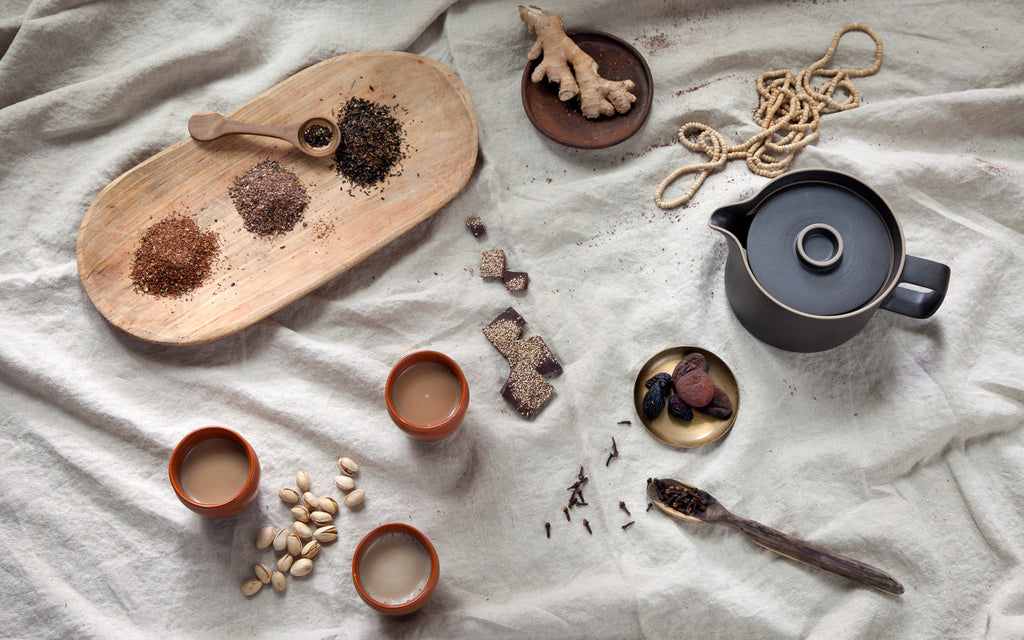Imagine yourself waking up on a cool, rainy Monday morning. The light from your kitchen window spills like yellow paint across the countertop, and from the open screen you feel a light breeze flowing around your body, giving you a chill from the brisk air outside. You decide to heat some water on the stove, and then you start searching through your cabinet for something soothing to drink, but also sweet enough to lift your spirit for the day ahead. You rummage through typical packs of Green Tea, Earl Grey, and that Peppermint that you’ve never touched, and then it hits you, “I’d really like some Masala Chai.”

Masala Chai (a.k.a. Chai Tea) is a beverage full of powerful taste. It’s origins date back to thousands of years ago in royal South Asian kingdoms, and over time, variations of the drink have become staples in many homes and coffee shops around the world. In Santa Monica, CA, one coffee shop owner with roots in both India and the UK, Roopinder Bhullar, swears that Masala Chai has natural healing powers that can benefit anyone who drinks it. The approach she uses at her venue—Café 212 Pier—is one that is firmly established in the idea that the ancient tea is purely medicinal, as well as delicious! So many people are unaware of its tremendous healing properties, and she recommends that “every person should drink a tumbler of it to start their day off right.”
“When you add all of the natural spices together, it becomes very delicious.”
Based on its simplistic recipe of natural spices, Masala Chai is a staple of Indian cultures and traditions. If you are living in India, as soon as anyone walks into your door, you would prepare them a cup of Chai without hesitation. “It’s a welcoming drink,” Roopinder grins from ear to ear. “No one asks you if you would like something to drink or anything like that, they just give you the tea and welcome you into their home.” It’s customary for a family to offer anyone, no matter where they came from, a cup of Chai, and the people of the country do this to give blessings and good fortune to those who cross their threshold. A sense of community and togetherness is important for the balance of the human spirit, and the people believe that serving Masala Chai brings them closer to the essence of their spiritual being.

Along with being a great way to show hospitality, Masala Chai is packed full of ingredients that promote a healthy digestive system. One of the main components of authentic Masala Chai is cardamom pods. Cardamom is a sweet, aromatic seed from several plants of the ginger family (Zingiberaceae). The pods are harvested and dried, and then they are ready to be cooked with. The three seeds within the pod are what gives Masala Chai its distinct, bold flavor. Cardamom also serves as a neutralizer for the lactose within milk, which is how it benefits the digestive system. “Some people can’t eat lactose,” Roopinder says. “It makes them bloated, and they’re not able to digest milk, but when you add all of the natural spices together, it becomes very delicious and actually makes the digestive process easier.” The reason why lactose can be neutralized is because cardamom seeds reduce the effects of highly acidic foods, while also reducing gas. Cardamom is a natural carminative, as well as an alkaline, and its qualities are well-known to fight other ailments like sore throats, respiratory issues, and even bad breath. Roopinder admits that even she suffers from a weak digestive system, but she feels “a million times better” whenever she makes herself a glass. “I would never drink normal tea,” she declares. “It makes me ill.”

“Watch the world go by and enjoy; it’s so easy.”
To make a great homemade Masala Chai, you’ll need just a few simple things:
- 1 saucepan, preferably with a deep enough base to bring contents to a boil.
- 1 cup of water
- 1 cup of whole milk—Roopinder suggests that the proper way to drink Chai is with creamy, delicious cow’s milk.
- 1 tea bag of black tea (English breakfast).
- 2 crushed cardamom pods
- ¼ piece of grated ginger
- sugar (to taste).

You’ll take the saucepan and place it over a medium heat on the stove. Then you’ll add equal parts of water and milk. Roopinder stresses that “you always have to make sure to use equal amounts of the two or else your tea will be either too weak or too thick.” Then start throwing in the other ingredients, along with the black tea bag. Let the the contents come to a boil, and then when you notice it change to a brownish color, you’ll know it’s ready to be served! After you take it off the stove, be sure to strain the the contents before drinking to eliminate all the access spices, the tea bag, and the thick layer of film on top. Lastly, you can add sugar to your preferred sweetness level. After that, “you’ll watch the world go by and enjoy,” Roopinder sighs. “It’s so easy.”














